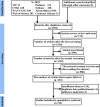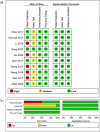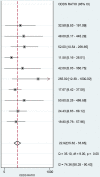Serum creatinine in predicting mortality after paraquat poisoning: A systematic review and meta-analysis
- PMID: 36812192
- PMCID: PMC9946265
- DOI: 10.1371/journal.pone.0281897
Serum creatinine in predicting mortality after paraquat poisoning: A systematic review and meta-analysis
Abstract
Although the prognostic value of blood creatinine levels in patients with paraquat (PQ) poisoning has been studied for a long time, the results are still controversial. Therefore, we performed the first meta-analysis to comprehensively assess the value of blood creatinine in predicting the prognosis of patients with PQ poisoning. We searched PubMed, EMBase, Web of Science, ScienceDirect, Cochrane Library, China National Knowledge Infrastructure, China Science and Technology Journal Database, and China Online Journals to identify all relevant papers published up to June 2022. Data were extracted for pooled analysis, heterogeneity testing, sensitivity analysis, publication bias analysis, and subgroup analysis. Ultimately, 10 studies involving 862 patients were included. The I2 of diagnostic odds ratio (DOR), sensitivity, specificity, positive likelihood ratio, and negative likelihood ratio of this study were all greater than 50%, which showed the existence of heterogeneity in this study, and a random effects model was used for the combination of the above five effect sizes. Pooled analysis showed a high predictive value of blood creatinine for prognosis of PQ poisoning [pooled DOR:22.92, 95% confidence interval (CI):15.62-33.65, P < 0.001]. The combined sensitivity, specificity, positive likelihood ratio, and negative likelihood ratio were 86% (95% CI: 0.79-0.91), 78% (95% CI: 0.69-0.86), 4.01 (95% CI: 2.81-5.71), and 0.17 (95% CI: 0.12-0.25), respectively. Deeks publication bias test revealed there was publication bias. Sensitivity analysis showed no significant differences in the estimates of impact. Serum creatinine is an effective predictor of mortality in patients with PQ poisoning.
Copyright: © 2023 Huang et al. This is an open access article distributed under the terms of the Creative Commons Attribution License, which permits unrestricted use, distribution, and reproduction in any medium, provided the original author and source are credited.
Conflict of interest statement
The authors have declared that no competing interests exist.
Figures







Similar articles
-
Base excess in predicting the prognosis of patients with paraquat poisoning: A meta-analysis.Medicine (Baltimore). 2019 Jun;98(23):e15973. doi: 10.1097/MD.0000000000015973. Medicine (Baltimore). 2019. PMID: 31169729 Free PMC article.
-
Comparison of severity index and plasma paraquat concentration for predicting survival after paraquat poisoning: A meta-analysis.Medicine (Baltimore). 2020 Feb;99(6):e19063. doi: 10.1097/MD.0000000000019063. Medicine (Baltimore). 2020. PMID: 32028427 Free PMC article.
-
[Early white blood cell count in predicting mortality after acute paraquat poisoning: a Meta-analysis].Zhonghua Wei Zhong Bing Ji Jiu Yi Xue. 2019 Aug;31(8):1013-1017. doi: 10.3760/cma.j.issn.2095-4352.2019.08.020. Zhonghua Wei Zhong Bing Ji Jiu Yi Xue. 2019. PMID: 31537230 Chinese.
-
Arterial lactate in predicting mortality after paraquat poisoning: A meta-analysis.Medicine (Baltimore). 2018 Aug;97(34):e11751. doi: 10.1097/MD.0000000000011751. Medicine (Baltimore). 2018. PMID: 30142762 Free PMC article. Review.
-
Sequential organ failure assessment in predicting mortality after paraquat poisoning: A meta-analysis.PLoS One. 2018 Nov 16;13(11):e0207725. doi: 10.1371/journal.pone.0207725. eCollection 2018. PLoS One. 2018. PMID: 30444919 Free PMC article.
Cited by
-
Association between serum creatinine levels at emergency admission and outcomes in patients with exertional heat stroke: a multicenter cohort study.World J Emerg Med. 2025 May 1;16(3):269-272. doi: 10.5847/wjem.j.1920-8642.2025.051. World J Emerg Med. 2025. PMID: 40406294 Free PMC article. No abstract available.
References
Publication types
MeSH terms
Substances
LinkOut - more resources
Full Text Sources

